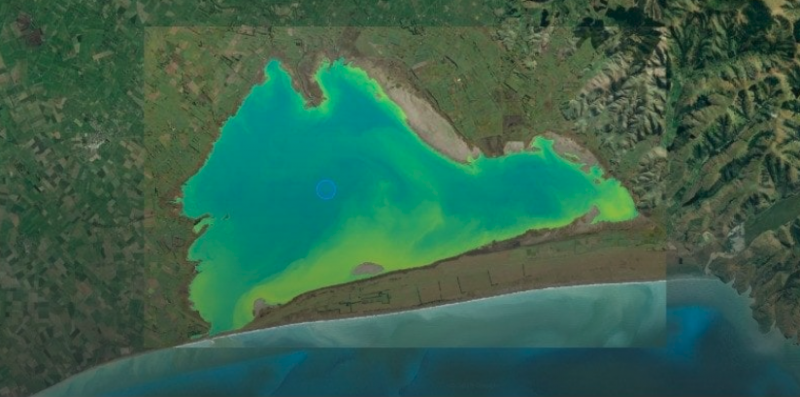Satellite-based Lake Health Monitoring System Identifies Quality Changes in Real Time
Published on by Water Network Research, Official research team of The Water Network in Technology
Seequent wins New Zealand aerospace innovation challenge; continues to expand its geoscience solutions to help solve earth, environment and energy challenges
Seequent is developing a satellite-based remote sensing solution that could virtually monitor the water quality of every lake globally. Seequent’s Lake Indicator Modelling System (SLIMS) can capture water quality data across many hundreds of lakes at once and model and visualise it through time, to help freshwater scientists identify lake health changes as they occur.

Screenshot by Seequent
Seequent was awarded the grand prize at the New Zealand Aerospace Challenge 2019 on Friday after demonstrating how its globally scalable SLIMS solution could effectively and economically monitor the health of all New Zealand’s 3,820 lakes. With currently only 2% of lakes currently monitored via established methods of lake water sampling and analysis, SLIMS enables organisations to monitor changes in lake conditions with the ability to use historical satellite data to identify seasonal trends. This allows users to identify lakes exhibiting any unexpected change for closer monitoring and management.
The Challenge, powered by global aerospace giant Airbus , and delivered by ChristchurchNZ and SpaceBase, sought solutions to identify, monitor or measure water or soil pollution using satellite data and unmanned aircraft technology.
Daniel Wallace , Seequent General Manager for Civil and Environmental, said the company jumped at the opportunity to participate in the Challenge to apply their innovative technology above ground in an exciting new space with huge potential to positively impact sustainability.
“Water quality and the health of our lakes sustains our way of life. It’s not economical to visit all lakes to monitor adverse environmental impacts, but with satellite remote sensing every lake can be monitored virtually. Algal blooms, sediment events and other adverse changes in lake health, which could otherwise be unseen and unknown suddenly emerge with our new monitoring solution. Subsequently these lakes could be visited to further investigate the health degradation.”
Seequent’s multi-disciplinary team, which included collaborators from Lincoln Agritech and the Waterways Centre for Freshwater Management, also received support from Environment Canterbury and the University of Waikato . The team received a cash prize of $30,000, over $15,000 of Airbus data vouchers, $2,500 of legal support and an offer of commercialisation support from Xstart , a tech focused incubator based at the University of Canterbury’s Centre for Entrepreneurship.
“To be recognised among such an impressive range of solutions is humbling and rewarding for our team,” Wallace said.
To encourage future aerospace breakthroughs in New Zealand, Seequent donated their cash prize back to the Challenge organisers to be used for future challenges, or as seed funding for small businesses in the aerospace industry.
Andrew Mathewson, Managing Director Airbus Australia Pacific, said the Challenge demonstrated that space technology and sustainability are converging in new and exciting ways.
“There is so much opportunity to use satellite data to better manage agricultural activities, but also to combat global environmental challenges like climate change. Seequent’s solution is a great example of this type of innovative and practical technology to enable better management of our environment,” Mathewson said.
Entries were judged by Valentin Merino Villeneuve, Head of Airbus Defence & Space Australasia, alongside New Zealand’s top space and agritech industry leaders. Merino Villeneuve announced the winners with Hon Dr Megan Woods, Minister of Research, Science and Innovation.
“Seequent’s winning solution demonstrated the potential of commercialising existing satellite data to monitor environmental challenges on the ground. It is these tangible solutions that will drive innovation and change in how we research and respond to our changing world,” said Merino Villeneuve.
How Does Seequent’s Lake Indicator Modelling Solution (SLIMS) Work?
In New Zealand, an overall picture of the health of lakes is based on the Trophic Level Index (TLI) which is calculated using four separate water quality measurements – total nitrogen, total phosphorous, water clarity, and chlorophyll-a. The water quality in each lake is assigned a number between 1 and 7, the lower the number representing the better the water quality.
Seequent’s SLIMS solution remotely senses ‘Indicative TLI’, based on Chlorophyll-A (visible algal biomass) and Secchi depth (visual clarity of water), captured via spectral analysis from space and models the two components to provide base-level water quality information for many thousands of water bodies with each satellite flyover. Results can be packaged and deployed alongside lake monitoring data collected by traditional lake sampling.
Attached link
https://www.seequent.com/satellite-based-lake-health-monitoring-system-an-aerospace-winner/Media
Taxonomy
- Water Quality
- Data Management
- Water Monitoring
- Remote Sensing & Data Analysis
- Water Monitoring
- Lake Management
- Water Quality Research